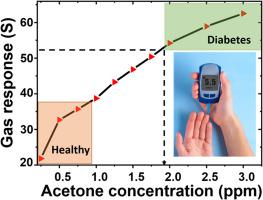Sensors and Actuators B: Chemical ( IF 8.4 ) Pub Date : 2021-09-16 , DOI: 10.1016/j.snb.2021.130733 Bharat Sharma 1 , Ashutosh Sharma 2 , Jae-ha Myung 3

|
The n-n TiO2-SnO2 heterostructures composed of SnO2 nanoparticles (NPs) topped with TiO2 NPs have been produced by a novel hybrid reactive magnetron sputtering and pulse laser deposition for sensing acetone (C3H6O) vapors in the environment. The gas sensing characteristics of the TiO2-SnO2 heterostructures were measured over a range of operating temperatures (200–500 °C) and the optimal working temperature of 300 °C was fixed. Further, the adsorption of acetone gas on both (110) and (101) stoichiometric and reduced surfaces of TiO2-SnO2 are studied by density functional theory (DFT) calculations. The proposed TiO2-SnO2 sensor displayed an ultrasensitive response for detecting acetone vapors which is almost 12 times and a limit of detection of 0.02 ppm. DFT calculations showed that the adsorption of acetone gas on (110) and (101) facets is thermodynamically favorable. Moreover, TiO2-SnO2 heterostructures sensor displayed high gas response, selectivity, repeatability, and long-term stability. The developed sensor also demonstrated excellent resistance against humidity due to a good synergy between the component oxides, band bending, availability of chemisorbed oxygen, and adsorption-desorption mechanism at the TiO2-SnO2 heterojunction. This work provides a foundation for the development of advanced gas sensors for hazardous sensing of materials exposed to diabetic patients in the human environment.
中文翻译:

用于糖尿病环境生物标志物的 TiO2-SnO2 异质结构对丙酮的高选择性检测
nn TiO 2 -SnO 2异质结构由顶部覆盖有 TiO 2 NPs的 SnO 2纳米颗粒 (NPs)组成,通过一种新型混合反应磁控溅射和脉冲激光沉积来检测环境中的丙酮 (C 3 H 6 O) 蒸汽。TiO 2 -SnO 2异质结构的气敏特性在工作温度范围(200-500 °C)内测量,最佳工作温度为300°C。此外,丙酮气体在 TiO 2 -SnO 2 的(110) 和 (101) 化学计量和还原表面上的吸附 通过密度泛函理论 (DFT) 计算进行研究。所提出的 TiO 2 -SnO 2传感器显示出检测丙酮蒸气的超灵敏响应,几乎是 12 倍,检测限为 0.02 ppm。DFT 计算表明丙酮气体在 (110) 和 (101) 面上的吸附在热力学上是有利的。此外,TiO 2 -SnO 2异质结构传感器显示出高气体响应、选择性、可重复性和长期稳定性。由于组分氧化物、能带弯曲、化学吸附氧的可用性以及 TiO 2 -SnO 2 的吸附-解吸机制之间的良好协同作用,开发的传感器还表现出出色的耐湿性异质结。这项工作为开发先进的气体传感器提供了基础,该传感器用于检测人类环境中暴露于糖尿病患者的材料的危险性。

























 京公网安备 11010802027423号
京公网安备 11010802027423号